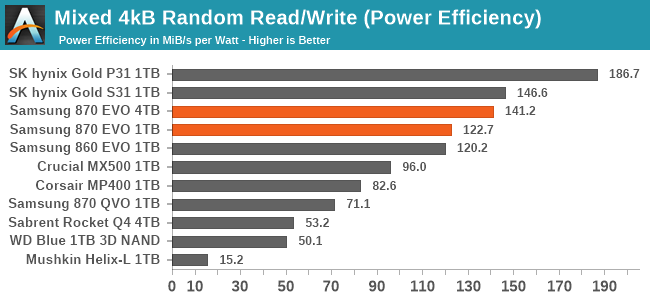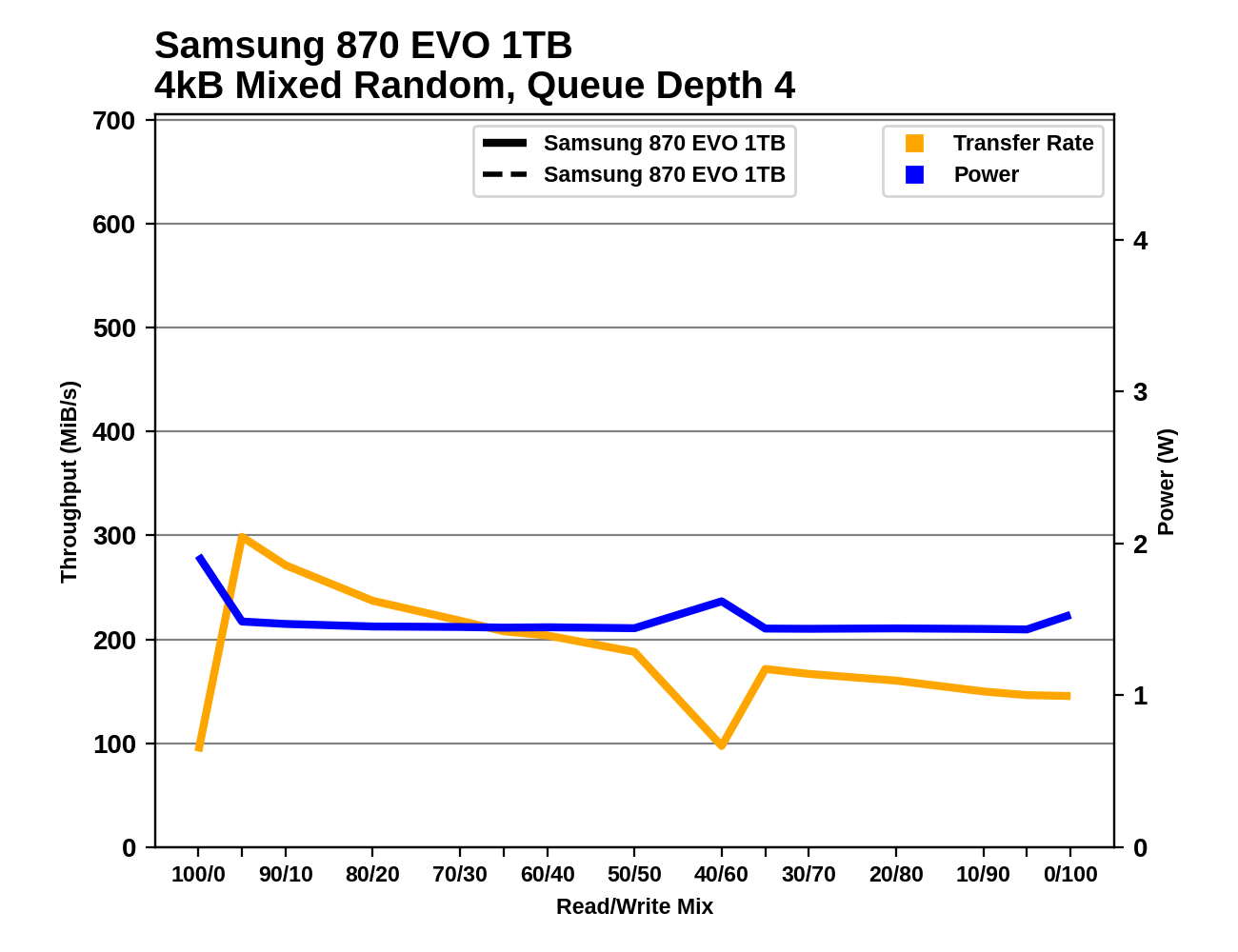The Samsung 870 EVO (1TB & 4TB) Review: Does the World Need Premium SATA SSDs?
by Billy Tallis on February 17, 2021 8:00 AM ESTMixed IO Performance
For details on our mixed IO tests, please see the overview of our 2021 Consumer SSD Benchmark Suite.
 |
|||||||||
| Mixed Random IO | Mixed Sequential IO | ||||||||
The mixed random IO test provides the Samsung 870 EVO with one of its biggest performance wins yet over the rest of the SATA field and the entry-level NVMe competition. But most of that comes from the capacity advantage the 4TB model has over most of these comparison drives; the 1TB 870 EVO is only about 5% faster overall than the 860 EVO. On the mixed sequential IO test, the SATA bottleneck keeps most of the performance scores within a fairly narrow range, and the 1TB 870 EVO's performance is actually a bit of a regression compared to its predecessor.
 |
|||||||||
| Mixed Random IO | Mixed Sequential IO | ||||||||
As with our separate tests of random reads and writes, the top efficiency scores for mixed random IO go to SK hynix, with Samsung's TLC drives turning in the next best scores and having a clear advantage over other competing brands. Over on the sequential IO side of things, the efficiency scores more closely mirror the performance scores, and the 870 EVO doesn't have any real advantage over other mainstream SATA drives.
 |
|||||||||
| Mixed Random IO | |||||||||
| Mixed Sequential IO | |||||||||
The 1TB 870 EVO's performance during the mixed random IO test is more consistent than the 860 EVO's, but still has a few unpleasant drops that aren't present for the 4TB model. On the mixed sequential IO test, the 1TB 870 EVO's performance is actually a bit less consistent than the 860 EVO. But aside from those occasional outliers, the general trend is for the 870 EVO to provide superior random IO performance and link-saturating sequential performance across a wide range of workload mixes.
Idle Power Management
Real-world client storage workloads leave SSDs idle most of the time, so the active power measurements presented earlier in this review only account for a small part of what determines a drive's suitability for battery-powered use. Especially under light use, the power efficiency of a SSD is determined mostly be how well it can save power when idle.
SATA SSDs are tested with SATA link power management disabled to measure their active idle power draw, and with it enabled for the deeper idle power consumption score and the idle wake-up latency test. Our testbed, like any ordinary desktop system, cannot trigger the deepest DevSleep idle state. For more details, please see the overview of our 2021 Consumer SSD Benchmark Suite.


The Samsung 870 EVO may feature an updated controller compared to the 860 EVO, but there's no real difference in idle power consumption, for either active idle or the desktop (non-DevSleep) idle states. Samsung's idle power figures are best in class, with SK hynix offering the only close competition.

The Samsung SATA drives all take about one millisecond to wake up from using SATA link power management. This is higher than several of the other SATA drives, but not really enough to be of much concern for system responsiveness.










136 Comments
View All Comments
Spunjji - Friday, February 19, 2021 - link
They won't be using SATA - and it will be spread across a whole lot more than one single drive.dotjaz - Friday, February 19, 2021 - link
But they are using SATA, nobody said it's single drive. It's how much storage you can fit into a 1U rack that matters, SATA is the only choice at the moment.schujj07 - Wednesday, February 17, 2021 - link
That is 100% false. NVMe is only surface area limited in the M.2 form factor. However, 99% of users do not need more than a 4TB NVMe SSD. Those that need larger drives can use M.2 > U.2 converters and get much larger SSDs.Beaver M. - Wednesday, February 17, 2021 - link
Yeah well, look into most SATA SSDs, their PCB isnt bigger than that of a M.2 SSD. Plus M.3 is coming = more space.Also theres U.2, which pretty much allows to use 2.5"-sized SSDs to be used (even on a M.2 connector).
SATA is dead. And they know it, else they would have released a new standard very long ago.
nevcairiel - Wednesday, February 17, 2021 - link
The solution to that is called U.2, NVMe with a cable.flgt - Wednesday, February 17, 2021 - link
^^^CaedenV - Wednesday, February 17, 2021 - link
not really? You are typically limited to 8 or 16 chips with most SSDs, and you can hold that on a long double-sided m.2 just fine. If you are going with more than that then you are looking something extremely custom with a built in raid of some sort and that is going to be stupidly expensive and not for the consumer market.Just look at the pic of that 4TB board. Maybe 4 storage modules in it assuming there are 2 more on the other side? You can easily fit that on m.2 with room to spare.
flyingpants265 - Thursday, February 18, 2021 - link
Storage in general is kinda dead. People buy 2tb drives very reluctantly if they want to add space.DanNeely - Wednesday, February 17, 2021 - link
SATA as an SSD interface is going nowhere. SATA as an HDD interface probably has 5-10 years left before the price crossover finally kills spinning rust off.If at some point in the future we do see a new SATA spec; it'll be because mass market spinning rust for NASes has gotten fast enough to bottleneck: In which case they'll backport the faster transport parts of the 2x as fast SAS standard to make SATA4.
wicketr - Wednesday, February 17, 2021 - link
SATA at this point is need of major changes to keep up. They can't do a minor refresh at this point. With that in mind, I hope they change the cable so that it incorporates power into it as well. And they've got to shoot for something like 50Gb/s.At this point the latest USB spec is faster and provides power in a similar sized port. SATA should be able to beat that and it's a shame they haven't done so yet.